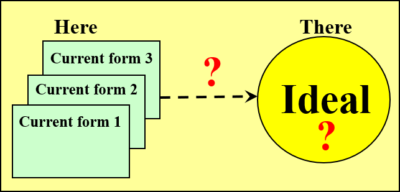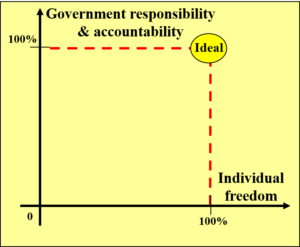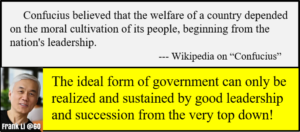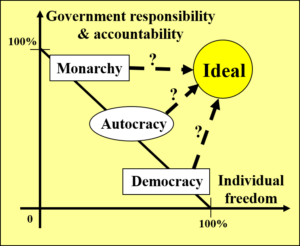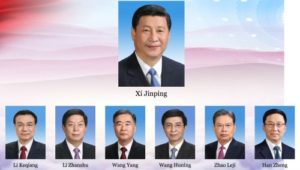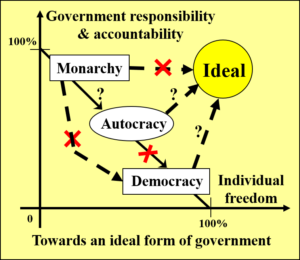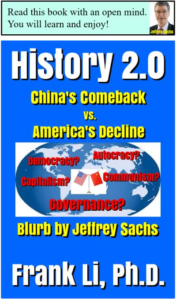In this post, I will ask and answer two critical questions:
- What is an ideal form of government?
- How to get there from here?
1. What is the role of government?
There are two major views:
- Chinese view.
- American view.
Let me elaborate on each …
1.1 The Chinese view
Below is an excerpt from Politics Theory – Confucius on the proper role of government.
Bottom line: Confidence (or trust) in government is everything. In other words, the government must be responsible and accountable.
1.2 The American view
Maximal freedom for individuals (or minimalist governance), as shown (or implied) by the image below.
2. Definition: what is an ideal form of government?
By combining both the Chinese view and the American view, let’s define the ideal form of government in two dimensions as follows:
- Individual freedom: the government must ensure maximum freedoms for its citizens, including free speech, free press, and religious freedom.
- Government responsibility & accountability: People must have confidence in the government.
What, then, is the responsibility of a government?
Do those things that are beyond the private sector.
Four examples:
- Working for the people (i.e., rich and poor), including everything “public”, from public safety to public health.
- Striving for “harmony” by balancing between socialism (e.g., a safety net) and capitalism (e.g., making money and prosperity).
- Undertaking mega infra-structure projects (e.g., highways and railways).
- Defending the country while avoiding unnecessary wars.
For more, read What is the role of government?
3. Where are we today?
Today, there are mainly three forms of government as follows:
- Monarchy: It is ruled by a king (or queen). What about a dictator? A dictator with a family member in succession is essentially a king. One example: North Korea.
- Republic-Democracy: one person, one vote without discrimination (e.g., race or gender). One prominent example: America.
- Republic-Autocracy: In this form of government, there is neither a king (as in a monarchy) nor any free election for people to choose their leaders (as in a democracy). Instead, a team of elites selects the next leaders for the country. One main example: China.
Let’s examine these three forms one by one.
3.1 Monarchy
This form of government represents the past. It can be highlighted as follows:
- Individual freedom: People have little freedom. Living at the whim of the king, the people are not empowered. As a result, monarchy has been unable to advance from feudalism to capitalism, virtually preventing prosperity.
- Government responsibility & accountability: There is no doubt about who is in charge: the king! Better yet, the king promotes permanency, with one supreme goal: passing the kingdom to his designated heir. He is, therefore, totally accountable.
3.2 Republic–Democracy
This form of government is fashionable today. It can be highlighted as follows:
- Individual freedom: People have more freedoms than in any other form of government.
- Government responsibility & accountability: The government is often neither responsible nor accountable for one main reason: Everything is short-term, for the next election only. Nothing is long-term, with politicians mortgaging the future to get elected today. As a result, a leading democracy like America is deeply in trouble.
3.3 Republic–Autocracy
This form of government is the newest and China has it. It can be highlighted as follows:
- Individual freedom: People have few freedoms, unless they benefit the whole. They do not elect their own leaders. Instead, a few elites do, by selection.
- Government responsibility & accountability: The government is relatively responsible and accountable. Two examples.
- In 1978, the government started embracing capitalism, bringing prosperity to China on such a massive scale over such a short time span that it is simply unprecedented in human history.
- Recent Chinese leaders have proven to be far more competent than many democratically elected leaders, such as Presidents George W. Bush, Barack Obama, Donald Trump, and Joe Biden.
4. Leadership and succession
4.1 Monarchy
The founding king of a dynasty is an able man, by definition. The biggest problem is that the descendants in his bloodline are unlikely to be as able as the king. As a result, a dynasty typically lasts only for several generations.
Any doubt? Look at Chinese history over the past 2,000 years!
4.2 Republic–Autocracy
Simply put, the Chinese Presidency is an earned emperorship. It has all the advantages of a monarchy, without its biggest problem: succession via the bloodline – Only proven winners need apply.
4.3 Republic–Democracy
There is neither assurance of adequate leadership nor succession at the top.
Interestingly, most so-called “democracies” in East Asia are mottled with monarchical relationships, such as Taiwan (father-son), South Korea (father-daughter), Singapore (father-son), the Philippines (mother-son), and Japan (multiple father-son examples). All of them, even under the guise of democracy, are actually more monarchical than China!
What about America?
5. Summary – Intermediary
The image below illustrates, qualitatively, where the three forms of government stand with regard to “individual freedom” and “government responsibility & accountability”.
Specifically, monarchy and democracy are at the two extreme ends, while autocracy is in the middle, with “balance”.
The big question: how to reach the ideal from here?
6. How to get there from here?
Now, let’s discuss how to reach the ideal in all three forms, one by one.
6.1 Monarchy
It has no future, either in theory as it does not represent the people, or in practice as most countries under monarchy are poor. However, revolutions (e.g., the Arab Spring) are unlikely to bring any solution. Two examples:
- The Mideast: Look at Iraq and Libya!
- China: It has had several revolutions over the past 200 years. None of them changed anything essentially: China remained poor and weak, until recently when it peacefully transformed itself into “state capitalism”.
Note that there is not a single precedent for a 3rd world country to achieve prosperity via democracy. The key to prosperity is capitalism, not democracy.
If a country is a monarchy, it needs a king like China’s Deng Xiaoping. Deng was a dictator – Not all dictators are bad for their countries! Deng used his power wisely for the good of the country: He laid the monumental groundwork for China, not only economically (i.e., capitalism), but also politically (i.e., state capitalism), which led to China’s huge success today, with no end in sight.
6.2 Republic–Autocracy
China arrived at its current form of government for two main reasons:
- Her previous struggles over the past 200 years, at least. Give Mao credit for unifying China in 1949, although he ruined China’s economy and caused untold damage to China from 1949 to 1976.
- By accident. Mao’s only able son, Mao Anying, was killed in the Korean War, thanks to the West (“Amen”). Otherwise, today’s China, under Mao Jr. or Mao III, could be just as bad as today’s North Korea – one of the worst on earth!
Although China’s political system appears to be the best available for now, it is fundamentally flawed in at least one critical aspect: who are the seven individuals in the Standing Committee of the CPC Politburo, as shown below?
As a matter of fact, these seven individuals are not even legitimate by Western standards, because they are not elected by the people.
However, let’s get out of the trap of Western ideology and think rationally: changing from a de facto emperor (Mao) to “an earned emperorship” (after Mao) was monumental progress not only in Chinese history, but also in human history: a new form of government was born!
Better (or worse, depending on your viewpoint) yet, this new Chinese system of autocracy has been dramatically out-performing the Western [liberal] democracy over the past few decades, with no end in sight.
For the legitimacy of the Chinese government, read What is China, anyway?
China faces a huge political challenge: how to further transform its political system into a form that is progressively more and more truly of/by the people? This issue must be resolved for China’s success to be long-term, and the only way to do it is via an expanded autocracy by incorporating some democratic elements. However, the expanded autocracy must not be like American democracy in any way.
Leadership matters. The smooth ride set out by Deng is expiring. New greatness must appear to continue China’s ascent. President Xi looks good so far, but he must make sure to select a good successor!
6.3 Republic–Democracy
Democracy, as America practices it today, is hopeless.
Why has it suddenly stopped “working”?
Because of China’s comeback and the incompetence of Western democracy in general.
Any doubt?
Just look at this simple fact: China is now the largest lender to both America and Europe.
Did anyone envision this at the turn of the 21st century?
More profoundly, democracy looks more and more like communism as a short-term fad (What is America, anyway?).
Is America’s time up now?
No, not yet.
What is the solution?
Reform our failing political system, as I have suggested in my latest book!
7. Summary – Final
The image below illustrates, qualitatively, how to get there from here.
It is a two-way race between autocracy and democracy, with monarchy out (unless it is moved to autocracy first).
America, reform our failing political system, as I have suggested (History 2.0 – China’s Comeback vs. America’s Decline), or become a fiddle, second to China!
